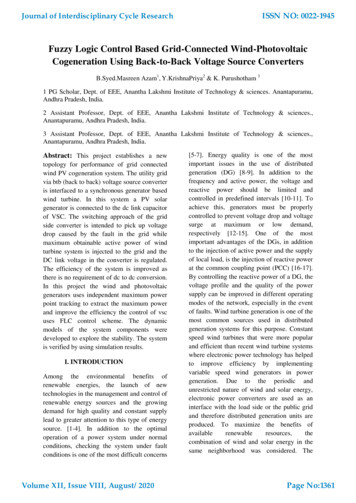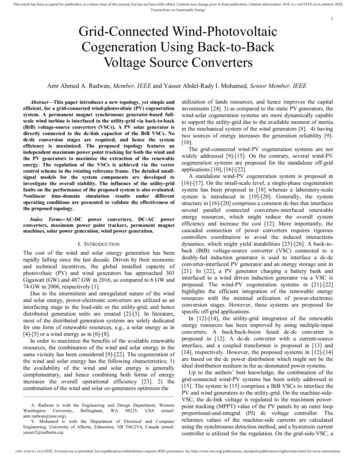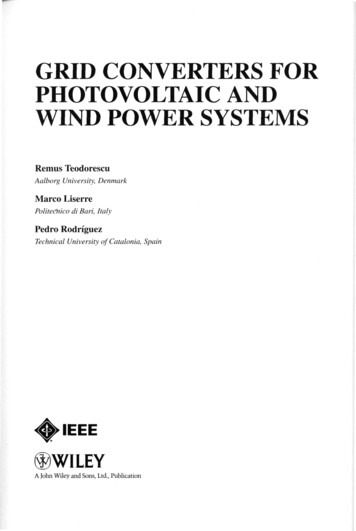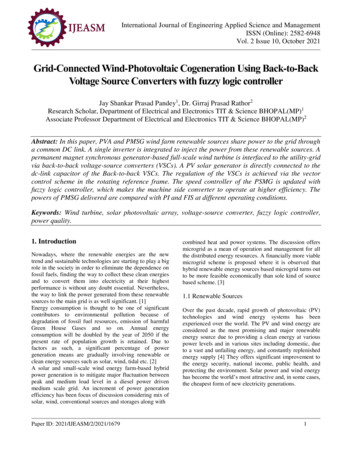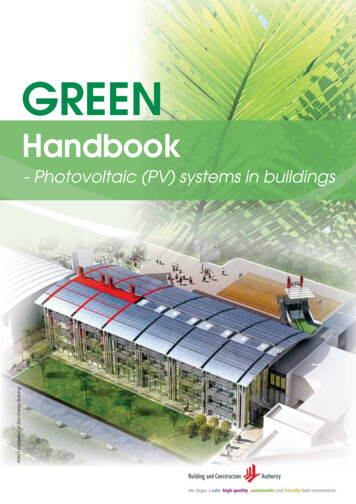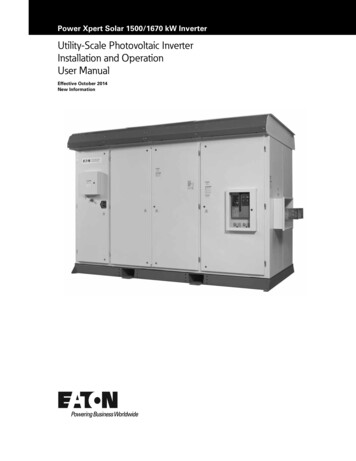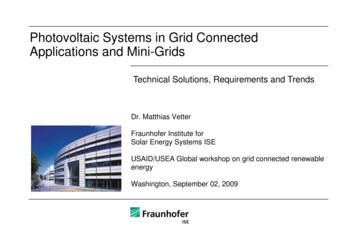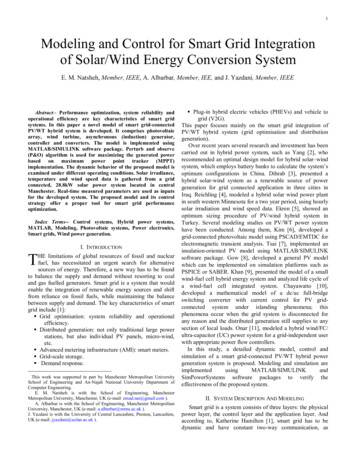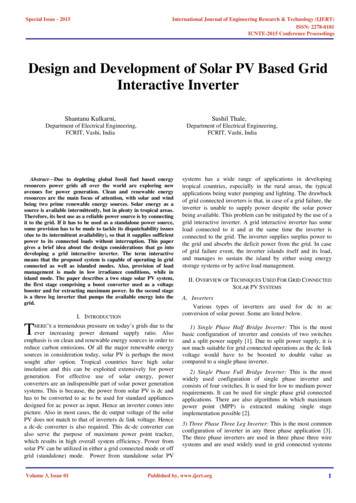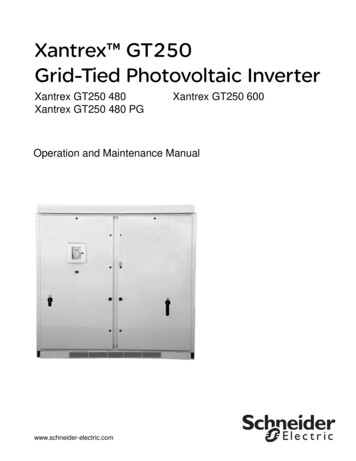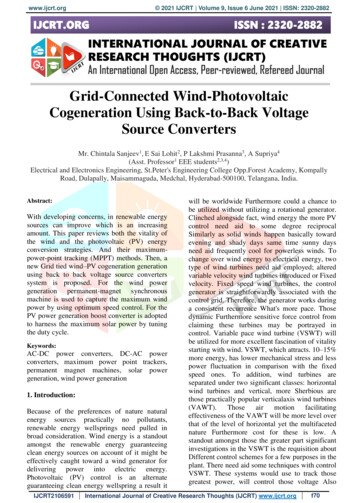
Transcription
www.ijcrt.org 2021 IJCRT Volume 9, Issue 6 June 2021 ISSN: 2320-2882Grid-Connected Wind-PhotovoltaicCogeneration Using Back-to-Back VoltageSource ConvertersMr. Chintala Sanjeev1, E Sai Lohit2, P Lakshmi Prasanna3, A Supriya4(Asst. Professor1 EEE students2,3,4)Electrical and Electronics Engineering, St.Peter's Engineering College Opp.Forest Academy, KompallyRoad, Dulapally, Maisammaguda, Medchal, Hyderabad-500100, Telangana, India.Abstract:With developing concerns, in renewable energysources can improve which is an increasingamount. This paper reviews both the vitality ofthe wind and the photovoltaic (PV) energyconversion strategies. And their maximumpower-point tracking (MPPT) methods. Then, anew Grid tied wind–PV cogeneration generationusing back to back voltage source converterssystem is proposed. For the wind powergeneration permanent-magnet synchronousmachine is used to capture the maximum windpower by using optimum speed control. For thePV power generation boost converter is adoptedto harness the maximum solar power by tuningthe duty cycle.Keywords:AC-DC power converters, DC-AC powerconverters, maximum power point trackers,permanent magnet machines, solar powergeneration, wind power generation1. Introduction:Because of the preferences of nature naturalenergy sources practically no pollutants,renewable energy wellsprings need pulled inbroad consideration. Wind energy is a standoutamongst the renewable energy guaranteeingclean energy sources on account of it might beeffectively caught toward a wind generator fordelivering power into electric energy.Photovoltaic (PV) control is an alternateguaranteeing clean energy wellspring a result itIJCRT2106591will be worldwide Furthermore could a chance tobe utilized without utilizing a rotational generator.Clinched alongside fact, wind energy the more PVcontrol need aid to some degree reciprocalSimilarly as solid winds happen basically towardevening and shady days same time sunny daysneed aid frequently cool for powerless winds. Tochange over wind energy to electrical energy, twotype of wind turbines need aid employed; alteredvariable velocity wind turbines introduced or Fixedvelocity. Fixed speed wind turbines, the controlgenerator is straightforwardly associated with thecontrol grid. Therefore, the generator works duringa consistent recurrence What's more pace. Thosedynamic Furthermore sensitive force control fromclaiming these turbines may be portrayed incontrol. Variable pace wind turbine (VSWT) willbe utilized for more excellent fascination of vitalitystarting with wind. VSWT, which attracts. 10–15%more energy, has lower mechanical stress and lesspower fluctuation in comparison with the fixedspeed ones. To addition, wind turbines areseparated under two significant classes: horizontalwind turbines and vertical, more Sherbious arethose practically popular verticalaxis wind turbines(VAWT). Thoseair motionfacilitatingeffectiveness of the VAWT will be more level overthat of the level of horizontal yet the multifacetednature Furthermore cost for these is low. Astandout amongst those the greater part significantinvestigations in the VSWT is the requisition aboutDifferent control schemes for a few purposes in theplant. There need aid some techniques with controlVSWT. These systems would use to track thosegreatest power, will control those voltage AlsoInternational Journal of Creative Research Thoughts (IJCRT) www.ijcrt.orgf70
www.ijcrt.org 2021 IJCRT Volume 9, Issue 6 June 2021 ISSN: 2320-2882recurrence of the load Also diminish controlvariance. Pitch control is a system will controlconcentrated starting with the VSWT. Mostextreme energy fascination starting with thoseVSWT may be attained utilizing straightcontrol; fuzzy logic control furthermore hillclaim searching (HCS) strategy. Due to efficientand economical utilization of renewableenergies, some of renewable energy resourcessuch as wind turbine and solar array areintegrated. Because of dependency on windspeed and sun irradiance in such systems, theirreliability in satisfying the load demandsdecreases under all conditions. Hence, somestudies propose the combination of a dieselgenerator as a backup and wind/solar powergenerationsystems.Thiseffectivenessexpansion of the PV energy preparing systemwill be futile In the MPPT control does notguarantee that greatest energy may beconcentrated starting with those PV array, bothtoward an enduring state and under fluctuatingclimatic states. In fact, the total efficiency of thepower processing system is almost the productof the conversion efficiencies, which must bemaximized by taking into account the extremelyvariable operating conditions throughout the dayas well as the MPPT efficiency. There aremultiple MPPT techniques [20] that could becompared using different criteria (Table 1). Themain techniques are dP/dV or dP/dI feedbackcontrol, incremental conductance (IncCond),and hill climbing {or perturbation– observation(P&O)}.the same leg(s) from claiming inverter because ofEMI effect, inappropriate terminating of switches,aggravation out breaking and nonattendance ofcross conduction security inside the gate-driversitself and so on. This prompt shorting fromclaiming wellspring alternately dc connectioncapacitor through the shortedleg(s) of inverter,causing a large current flow and damage to thesystem. A voltage source inverter is one of theexamples. Proposed system is designed formaximum energy captured from the wind turbine /solar array and deliver to utility grid.2. Related Works:The brief introduction of different modules used inthis project is discussed below:Solar Array:When light falls on a solar cell, electrons in theabsorber layer are excited from a lower-energy“ground state,” in which they are bound to specificatoms in the solid, to a higher “excited state” inwhich they can move through the solid. In theabsence of the junction-forming layers, these“free” electrons are in random motion and so therecan be no oriented direct current. The addition ofjunction-forming layers, however, induces a builtin electric field that produces the photovoltaiceffect. In effect, the electric field gives a collectivemotion to the electrons that flow past the electricalcontact layers into an external circuit where theycan do useful work.Permanent Magnet Synchronous Generator:On photovoltaic framework a front-end supportconverter will be by and large obliged towardthe enter about inverter will match the loadprerequisites.Previously,suchDC-ACalternately DC-DC AC energy converters, therewill be An likelihood for concurrent exchangingfrom claiming switches (IGBTs/MOSFETs) ofIJCRT2106591Let’s assume that the machine is running at no loadand a positive torque is applied to the shaft; that is,the rotor flux angle is advanced ahead of the statorflux angle. As in the case of motor operation, thestator currents will change to create the newconditions of equilibrium shown in Figure 1, undergenerator. If the machine is initially underexcited,condition (a) in Figure 1 obtains. On the otherhand, if the machine is overexcited, condition (b)in FigureInternational Journal of Creative Research Thoughts (IJCRT) www.ijcrt.orgf71
www.ijcrt.org 2021 IJCRT Volume 9, Issue 6 June 2021 ISSN: 2320-2882It is important to note that when “seen” from theterminals, with the machine operating in theunderexcited mode, the power factor angle (#1)is leading (i.e., I1 leads V1). This means themachine is absorbing reactive power from thesystem. The opposite occurs when the machineis in the overexcited mode. As for the motoroperation, an overexcited condition in thegenerating mode also allows for greater powerdeliveries. As generators are normally called toprovide VARs together with watts, they arealmost always operated in the overexcitedcondition.The wind effect is very important in modelingwind turbines. Wind models describe windfluctuations in wind speed which causes powerfluctuation in generator. Four components areconsidered in describing a wind model as shownbelow:Where, are the Base wind, Gust wind, Ramp windand Noise wind components respectively in .Thebase component is a constant speed; wind gustcomponent could be described as a sine or cosinewave function or combination; a simple rampfunction and a triangular wave may describe theramp and the noise components respectively. Thewind speed in this study is shown in the simulationresults for the dynamic analysis of the systemduring wind speed change.MPPT CONTROL FOR SOLAR ENERGYCONVERSION SYSTEMFig:1This generator is connected through a back-toback converter to the grid. This providesmaximum flexibility, enabling full real andreactive power control and fault ride-throughcapability during voltage dips. The schematicdiagram and the equivalent circuit of PMSG areshown in Figures 2a and 2b, respectively. Theequivalent circuit nomenclature and details canbe found.Fig: 2aTo enhancing the efficiency of the photovoltaicpanel MPPT is utilized. According to themaximum power point theorem, the output powerof any circuit will be maximum whenever sourceimpedance equivalent to the load impedance, sothe MPPT algorithm is utilized to the problem ofimpedance coordination. In this paper work, theBoost Converter is utilized as impedancecoordination device between input and output bychanging the duty cycle of the converter circuit.Favorable position of the Boost is that low to highvoltage is acquired from the accessible voltage.Control algorithm, the PV voltage and current aresensed and then estimate the power, after that findthe change in power and voltage by comparing theprevious power and voltage; if change in power iszero then duty cycle will be same as previousotherwise duty cycle will change according to thefollowed conditionGRID CONVERTER CONTROLFig:2bWIND TURBINE ANDSTUDYWind Turbine ConceptIJCRT2106591SYSTEMOFMost inverters operate as current sources injectinga current that is sinusoidal and in phase with thegrid voltage, with a power factor equal or veryclose to unity. It is required that the invertersynchronizes with the fundamental component ofthe grid voltage, even in the cases when the gridvoltage is distorted or unbalanced or when the gridfrequency varies. An example of synchronizationin steady state for a three-phase system is shown inInternational Journal of Creative Research Thoughts (IJCRT) www.ijcrt.orgf72
www.ijcrt.org 2021 IJCRT Volume 9, Issue 6 June 2021 ISSN: 2320-2882Fig.3, in which three phase wind photovoltaicco-generation system with load.irradiation profile, second section present to PVvoltage, third waveform represent to PV currentwhich is depends on solar irradiations profile ifirradiation is increases then PV current is increasesand whenever irradiations decreases then current isdecreases. Fourth wave shows the dc link voltagewhich is constant of magnitude 1400V. Fifth onerepresents to PV power generated.3. Proposed system:The proposed hybrid energy generation systemis depicted in Fig. 1. This system consists of ahorizontal axis and variable speed wind turbine,a solar array, permanent magnet synchronousgenerators, sinusoidal pulse width modulation(SPWM) converters, DC/DC converters, anadaptive feedback linearization controllerFig. 4. Performance of PV systemA .Performance of wind energy conversion system ofco-generation unitDemonstrating the performance of proposed systemunder normal conditions when wind speed is fixed at 12m / s with disturbance depicted in Fig. 5. When PMSGoperated near rated speed at 2.72 rad/s, active powergenerated from wind turbine is 2 MW andelectromagnetic torque of generator is - 0.68 MN-m(negative sign indicate that machine operated asgenerator). Machine side converter maintained DC linkvoltage at 1400V.4. RESULTS:MATLAB Simulink 17a is used to evaluatethe performance of the proposed co-generationsystem and controllers. For the energyconversion system utilized in this paper, pitchangle is assumed zero and yaw controlmechanism is not considered. It consists of anaerodynamic system based on wind speedmodel, wind power versus wind speed modeland etc., permanent magnet synchronousgenerator (PMSG), a SPWM AC/DC converter,a DC/DC boost converter, a DC/AC inverter andAC filters, PID controllers.A.Performance of PV systemFig. 4 shows the performance of PV system withtime 0 to 10 second of 100kW rating solarirradiation increases and decreases to performthe system. This section is divided into fivesection in which first section represent to solarIJCRT2106591Fig 5: Performance of wind energy cogeneration systemPerformance of grid of proposed cogeneration unitFig. 6 shows the performance of grid of cogenerationunit. Here performance of proposed system analyzed, inwhich first wave represents to grid voltage second oneto grid injected current third one is grid injected activepower while fourth one reactive power wave. It isobserved that whenever power generation by wind andPV increases then grid injected current is increases andtherefore active power is increases.International Journal of Creative Research Thoughts (IJCRT) www.ijcrt.orgf73
www.ijcrt.org 2021 IJCRT Volume 9, Issue 6 June 2021 ISSN: 2320-2882Fig 6: performance of grid of proposed co-generationunit5. CONCLUSION:[8] Nagai Baku M, AmekuKazumasa, RoyJitendroNath. Performance of a 3 kW wind turbinegenerator with variable pitch control system. ApplEnergy 2009:1774–82.[9] Simoes Marcelo Godoy, Bose Bimal K, SpiegelRoland J. Fuzzy logic based intelligent control of avariable speed cage machine wind generation system.IEEE Trans Power Electron 1997;12(1).[10] Hilloowala Robin M. Rule based fuzzy logiccontrol for a PWM inverter in a stand-alone windenergy conversion scheme. IEEE Trans IndAppl1996:57–65.Wind-PV Co-generation system connected tothe grid are increasing both in the number ofinstallations and also in the rated power of eachplant and will cover a significant percentage ofthe electric generation mix. In this article, acomprehensive overview of grid-connectedwind PV co-generation systems is presented.Different control techniques for proposedsystem such as PV MPPT, WECS MPPTcontrol. And Inverter control and itsperformance is validated through the MATLABSimulink version 2017a.Grid side convertercontrol is done to grid synchronization withpower (active and reactive) control.REFERENCES:[1] Y.-M. Cheng, Y.-C. Liu, S.-C. Hung, and C.S. Cheng, “Multi-input inverter for gridconnected hybrid PV/wind power system,”IEEE Trans. Power Electron., vol. 22, no. 3, pp.1070–1076, May 2007.[2] Snyder Brian, Kaiser Mark J. A comparisonof offshore wind power development in Europeand the US: patterns and drivers ofdevelopment. Appl Energy Abderrazak. A fuzzy logic supervisory foractive and reactive power control of a fixedspeed wind energy conversion system. ElectricPower Syst Res 2007.[4] Kamoji MA, Kedare SB, Prabhu SV.Experimental investigations on single stagemodified Savonius rotor. Appl Energy 2009:1064–73.[5] De Almeida Rogerio G, Castronuovo EdgardoD, Lopes JA. Optimum generation control in windparks when carrying out system operator request.IEEE Trans Power Syst 2006.[6] Tapia A, Tapia G, Ostolaza JX. Reactive powercontrol of wind farms for voltage controlapplications. Renew Energy 2004.[7] ThirigerTorbojorn, Linders J. Control by variablerotor speed of a fixed pitch wind turbine operation ina wide speed range. IEEE Trans Energy Convers1993;8(3):520–6.IJCRT2106591International Journal of Creative Research Thoughts (IJCRT) www.ijcrt.orgf74
the wind and the photovoltaic (PV) energy conversion strategies. And their maximum-power-point tracking (MPPT) methods. Then, a new Grid tied wind-PV cogeneration generation using back to back voltage source converters system is proposed. For the wind power generation permanent-magnet synchronous
